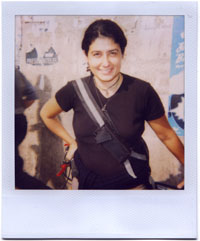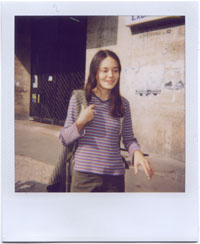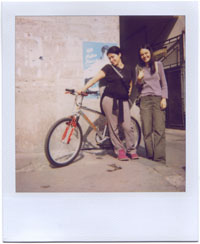 Yes.
Yes.
Irina Bucani & Anka Benera
Irina Bucani and Anka Benera are working together, they graduated very recently from the Art Academy, have realized their first bigger project and clearly state that their fate as artists is defined. they have decided for good that they will work in contemporary art. They were still overexcited about their professional meeting with curator Iara Boubnova and her Spanish colleague, both members of the curatorial team of the next European biennial Manifesta.
Irina Bucani or, as she prefers to be called, Bota, is 31 years old, Anka is 23.
- I understand that you have recently graduated from the Art Academy. Did you have the opportunity as students to take part in projects linked to contemporary art?
- How did your professors accept this? After all, the Art Academy is a conservative institution.
No problems at all, it even seems like they looked happy and supported us, but then at the exams themselves we had the feeling that they were taking revenge for it all. We took part in a festival for contemporary art, and immediately after that we had to take an exam. At the exam we presented a project similar to the one for the festival, rather than a student exercise, and our professors criticized us harshly. They were definitely surprised that we dared present just such a work for the exam.
- Have you felt some sort of pressure in the art circles and institutions as women artists?
No! Here among the students at the Academy, there are more women than men. In Bucharest, there are also more women working in contemporary art than men. But this is not the same in the southern parts of the country, so that a natural balance arises between the North and the South.
- What happened after you graduated? How do you make a living, do you have a chance to develop yourselves on the professional level? Do you work with a given curator or gallery, or do you prefer at this point to look for possibilities to realize your projects yourself?
Bota: After I graduated, my husband was providing for me. I've been married for four years. My husband is a photo journalist and has the possibility to get a much higher income than myself, so that he takes care of both of us financially.
Anka: I live with my parents. They provide for me, and I don't know when I'll be in a position to take care of myself.
Otherwise, all the projects we succeeded in realizing to date we have financed ourselves with our own resources, except for the last one, which received funding from the Center for Contemporary Art. There is no private funding from commercial companies, or it is very difficult to get. The only serious funding that can be found for contemporary art is from the Center for Contemporary Art in Bucharest (this is the restructured Soros Center). But maybe the problem lies with us, we are just not used to the system, and don't know how to raise funds for our projects. Nobody has explained to us how to deal with this problem. When we were students at the Academy nobody has explained how this is done.
- What kind of projects are funded by the Center for Contemporary Art in Bucharest?
They have a very well developed database and are open to new proposals. Whatever events happen in the sphere of contemporary art, if they fit their criteria they support them financially or look for other ways to get involved.
 -
How did you meet with the curators of Manifesta?
-
How did you meet with the curators of Manifesta?
As far as we know, important curators rarely come to Romania. We received information about the last meeting with Iara Boubnova and the Spanish curator through the Center for Contemporary Art. That's how this meeting came about, things were organized by the Center. As we said, they have a rich documentation there about what is happening in the sphere of contemporary art in Romania. When a curator is coming, looking for Romanian artists for their project, they can use the archive to select the people they want to meet with.
- Does this archive exist online on the Web?
No, only in physical form at the Center for Contemporary Art. As far as we know, there is an online magazine for contemporary art in Constanta, and the mailing list <nettime-ro>.
- Do you have an idea how your professional life may develop in the future? Do you have some kind of long-term plans in this respect?
No, we don't want to think of projects more than a year ahead. Of course we will try to find funding for realizing some of our ideas. But we think that we should not knock at the door of the curators and critics. We'll wait for them to notice us, or we'll try to find out what are the mechanisms so that they select our works for good exhibitions. See for instance in England, when we were there we saw how they work towards preparing future artists, still students, for their professional life. Brochures with information are published, meetings with curators and institutions organized, etc. In Romania there are no art managers, and there are many curators, but how can all these ideas be realized if you don't have any idea how funding can be raised for the projects.
We are dreaming of the possibility to develop projects with a curatorial approach. We are dreaming of the possibility to set up a Virtual Museum.
- How do you imagine this, and why a museum?
Well, because there is no museum of contemporary art in Romania. We don't see it exactly as a virtual museum, the way the term virtual is usually used. We have found a deserted factory, so that the museum will have a kind of real space. We want to take pictures of the entire space, and then digitalize it, turn it into a virtual space, and then in that virtual space we would set up quite really existing works, but again along the principles of photography and other computer techniques. This will not be only a virtual, but rather a possible museum.
- What is for you the context for contemporary art here?
 The
public is one of the fundamental problems. There is no interest. If there is
a public at all, it is always the same. And that's why it's not very satisfied.
Otherwise, in the society at large, there is not much information about what
artists do and why. The public is now being created, but this is an economic
question. Now a context is being created for the public. You don't need to have
grown up in museums in order to have a good visual culture. After all, the young
people who grew up with MTV and techno parties are better prepared in visual
terms as a public than the older generations before them. At the same time,
international contacts are very important for artists. The curators should travel
more, change their places, to get a better impression of what happens here or
there. We don't know how many curators of international projects pass through
Romania and when, looking for authors for their projects, or how one can secure
access to them and through them to the larger international events.
The
public is one of the fundamental problems. There is no interest. If there is
a public at all, it is always the same. And that's why it's not very satisfied.
Otherwise, in the society at large, there is not much information about what
artists do and why. The public is now being created, but this is an economic
question. Now a context is being created for the public. You don't need to have
grown up in museums in order to have a good visual culture. After all, the young
people who grew up with MTV and techno parties are better prepared in visual
terms as a public than the older generations before them. At the same time,
international contacts are very important for artists. The curators should travel
more, change their places, to get a better impression of what happens here or
there. We don't know how many curators of international projects pass through
Romania and when, looking for authors for their projects, or how one can secure
access to them and through them to the larger international events.
- Yes, you are speaking of the Art System on an international level. Will you permit me to quote from an interesting text by Alexander Brener, published in the Moscow Art Magazine <http://www.guelman.ru/xz/362/xx23/x2301.htm>? The article is entitled: "The Art of Waging a War Against an Institution." This is how Brener speaks of the Art System: "This system is flexible, structured in complex ways and continuously integrating ever new elements: from the latest brands of yogurt to the emigrant families from Africa and Asia, from the ultra-contemporary weapons to the new artistic movements. Yes, yes, that's how it is indeed: the artistic movements in the contemporary world serve the system of control and the system of production, like for instance sports and tourism." Perhaps if we want to solve some of our problems we will need to find mechanisms and means to turn ourselves into new brands of yogurt.
Well, if that's how things are, we'll try to sidestep the system, through personal initiative or whatever else. We don't want to become stars. We only want to have the opportunity to realize our projects, that's why we haven't given much thought to these questions.
Bota: Hmm, if I have to be a product, I don't want to be yogurt. I'd rather be a chocolate milk shake.
Dimitrina Sevova - In Someone Else's Skin (2001)
Index of the Interviews